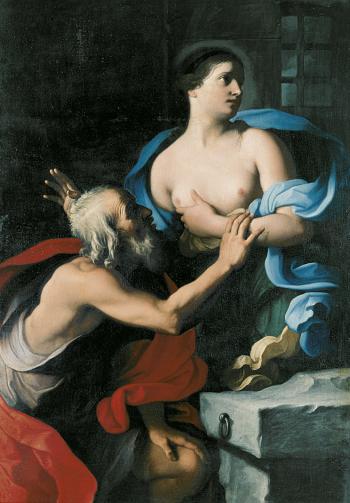Roman charity
Palazzo Baldeschi Museum

Gian Domenico Cerrini, known as il Cavalier Perugino
oil on canvas
1670 ca
The iconography of Carità romana (Roman Charity) derives from Valerio Massimo’s narration of an episode featuring an old and ailing Cimon, left to die of hunger in prison, who was rescued and nursed at the breast of his own daughter, Pero. The theme was a great 17th century favourite, partly due to Caravaggio’s portrayal of the subject in his Neapolitan Sette opere di Misericordia (Seven Works of Mercy). The correct attribution of Carità romana to Cerrini, by Giuliano Briganti, came around shortly before the artwork was acquired by the Cassa di Risparmio di Perugia in 1985. In 1999, it joined the Foundation’s collection.
Following an initial apprenticeship in Perugia, Cerrini moved to Bologna and thence to Rome where he completed one of the major undertakings of 17th century Rome, the decoration of the dome of the Church of Santa Maria della Vittoria. Following a brief stay in Florence, where he was brought into contact with the House of Medici, he returned to Rome and lived there until his death, completing commissions for prestigious clients such as the noble Barberini, Chigi, Colonna, Corsini, Pallavicini, Rospigliosi and Spada families.
Documentary sources list six paintings by Cerrini on the theme of Carità romana (Roman Charity). One was listed in Mattias de’ Medici’s 1659 inventory of the Villa Lapeggi; another was expedited from Rome in 1666 to an unknown prince of the House of Medici; a third is listed in the 1679 inventory of goods of Cardinal Neri Corsini; in 1690 another was among the artworks owned by Gian Domenico’s brother Tommaso. Two of the paintings were listed in the Perugian collections of Francesco Maria degli Azzi and Reginaldo Ansidei. In 2003 Federico Mancini suggested the Foundation’s Carità romana be identified as the one remembered by Orsini as being part of the Degli Azzi collection in 1784. Art historians concur in dating this piece at around 1670.